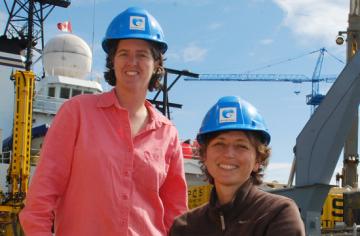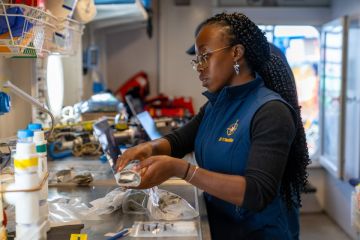NEPTUNE Canada successfully wires deep subsea volcanic region

Where on Earth can you find a volcanically active mountain range with sharp, glass-like rocks, deep fissures and rocky pinnacles spewing plumes of super-heated corrosive minerals and gases? At Endeavour Ridge, 300 km off the BC coast and 2.3 km below the ocean surface.
This is where a NEPTUNE Canada expedition has spent much of the past month, deploying cable, instruments and a video camera to complete installation of the world's first regional cabled ocean observatory.
NEPTUNE Canada (North-East Pacific Time-series Undersea Experiments) pioneers a new generation of ocean observation systems that—using power and the internet—provide continuous, long-term monitoring of ocean processes and events as they happen. It is managed by Ocean Networks Canada for a consortium led by the University of Victoria.
The entire observatory—which features an 800-km loop of powered fibre optic cable, power and communication nodes at five key scientific sites, and 600 sensors (to date) stationed on, under and above the ocean floor—has taken almost 10 years to plan, develop and install.
The installation team left Esquimalt on Sept. 12 aboard the University of Washington's research vessel R.G. Thompson. Also on board—and key to the expedition—is ROPOS, a remotely operated vehicle system managed by the Canadian Scientific Submersible Facility.
Endeavour Ridge is NEPTUNE Canada's most challenging site, where new volcanic seafloor is being created at the spreading boundary between the Juan de Fuca and Pacific tectonic plates. There are multiple volcanic eruptions in the region each decade, and more than 3,000 earthquakes a year.
"We're taking power and the internet to the dramatic environments of the mid-ocean ridge," says Dr. Mairi Best, associate director (science) of NEPTUNE Canada and co-chief of the expedition. "For the first time, anyone will be able to monitor this harsh but dynamic edge of a tectonic plate in real-time."
At Endeavour, the team's first task was to determine the best route through a rugged subsea mountain range for three 6-km extension cables, which would connect the node (installed in September 2009) with instruments at the main study site.
"Imagine installing a high-tech laboratory in a mountainous zone using only remotely operated robots, and add the challenges of operating at depth," says Dr. Lucie Pautet, NEPTUNE Canada's associate director (engineering) and the other co-chief of the expedition.
GIS software was used to hand-trace a route on bathymetry (underwater depth) maps from previous expeditions. Then ROPOS "flew" along the route, surveying the bottom with high-resolution sonar.
"For the trickiest parts, we crowded around the monitors in the operations room to watch the live video feed," says Pautet. "There were some surprises along the way—steep slopes ripe for an underwater avalanche, knife-edged cliffs, deep chasms and some very curious sea creatures. It was nerve-wracking and exhilarating at the same time."
As The Ring went to press, ROPOS was connecting 18 instruments, including seismometers to measure tectonic processes and moored instrument buoys to document ocean currents and chemical fluxes. A camera is also being deployed to observe the unique "black smoker" ecosystems that flourish in the main hydrothermal vent field.
"Endeavour will give us an unblinking look at how this volatile region fits into and influences marine and tectonic systems off Canada's west coast," says Best. "It represents a main recycling force in the Earth's chemical cycles, and a unique biosphere that informs us about constraints on life."
On the way to Endeavour, two major science platforms were installed at the Barkley Canyon node site on the continental slope. A two-ton vertical profiler system—the first of its kind in the world—will measure nutrients, light and temperature from the seafloor 400m up to the surface. Wally II, the second generation of the world's first internet-operated deep-sea crawler, is studying methane hydrate deposits on the seafloor.
To find out more about the final phase of NEPTUNE Canada's installation, including an installation blog and stunning images from the seafloor at Endeavour, visit the NEPTUNE Canada website: www.neptunecanada.ca.


